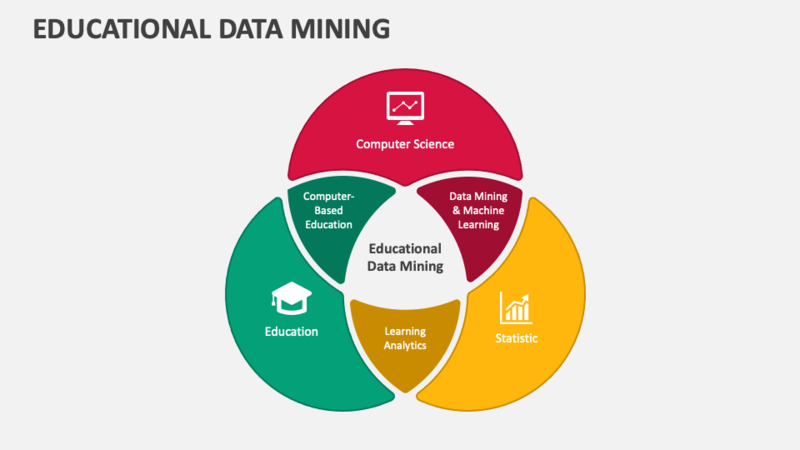Assessment for Learning MOOC’s Updates
Educational data mining (EDM)
Educational data mining (EDM) is a research field concerned with the application of data mining, machine learning and statistics to information generated from educational settings. At a high level, the field seeks to develop and improve methods for exploring this data, which often has multiple levels of meaningful hierarchy, in order to discover new insights about how people learn in the context of such settings.
Photo reference: https://www.collidu.com/media/catalog/product/img/c/8/c8721abd156e63cec99a1b728f40679a88b5c624159261c98aed5d1af10c0278/educational-data-mining-slide1.png
Educational data mining and learning analytics are really interested in how we can apply those techniques to educational data to study learning or to provide better real time support for learner as they are learning. And so, one of the first type of techniques that we can use is what we call prediction modeling, and more specifically two types of prediction modeling, classification and regression. The context of predictive modeling, what we want to do is we want to develop a model that can infer from one specific aspect of the data which we call the predicted variable, and this prediction can be done about future events, for example, trying to predict what the score of a student is going to be on a future standardized exam or they can be about something happening in the moment but the learning environment doesn't give us information about.
Another type of analysis that we do a lot and educational data mining is what we call latent knowledge estimation. So, the idea behind latent knowledge estimation is that we want to get an estimation of what the student knows and what the student doesn't know. And so, in order to do that, we assess the student's knowledge of a specific knowledge component using observation of when the student succeeded or failed at applying that knowledge component in the past
There are a lot of techniques that can be used including text minig algorithms, analysis of videa data, analysis of audio data. For example, video analysis, were we might look at the facial expression of a student as they are engaging with learning. They are engaging with learning content and then we can use those stable expressions to try to identify wheather tje student is confused, frustrated or bored. We could look at data from Kinect sensors that's going to give us information about the posture of the student, that's going to be able to track their movement, so we can look at whether a student leans in or leans backward. What does that mean? Does that mean that often when people lean in, that's because they're more engaged with the content.
Play video for highlighted transcript with text, And this is just an overview of different types of techniques, there's a lot of techniques that can be used including text mining algorithms, analysis of video data, analysis of audio data. For example, video analysis, we might look at the facial expression of a student as they're engaging with learnin, marked from 0 hours 10 minutes 6 seconds until 0 hours 10 minutes 25 secondsSo we can detect that.This was a really, really brief overview of what educational data mining and learning analytics are. They are very recent fields of study, but they are growing very rapidly due to little larger and larger amounts of digital data that comes from educational setting, and there's a lot of applications to educational data mining including the scientific study of the learning process itself, providing us insight on how to better design digital learning environments or using those model to automatically adapt digital learning environments.
Reference: https://www.coursera.org/learn/assessmentforlearning/lecture/yUKav/using-data-to-analyze-learning
Pause video for highlighted transcript with text, they're engaging with learning content and then we can use those stable expressions to try to identify whether the student's confused, frustrated, bored. We could look at data from Kinect sensors that's going to give us information about the posture of the student, that's going to be able to track their movement, so we can look at whether a student leans in or leans backward. What does that mean? Does that mean that often when people lean in, that's because they're more engaged with the content..., marked from 0 hours 10 minutes 22 seconds until 0 hours 11 minutes 30 seconSo we can detect that. And so, just to quickly conclude, this was a really, really brief overview of what educational data mining and learning analytics are. They are very recent fields of study, but they are growing very rapidly due to little larger and larger amounts of digital data that comes from educational setting, and there's a lot of applications to educational data mining including the scientific study of the learning process itself, providing us insight on how to better design digital learning environments or using those model to automatically adapt digital learning environments.
Play video for highlighted transcript with text, And this is just an overview of different types of techniques, there's a lot of techniques that can be used including text mining algorithms, analysis of video data, analysis of audio data. For example, video analysis, we might look at the facial expression of a student as they're engaging with learnin, marked from 0 hours 10 minutes 6 seconds until 0 hours 10 minutes 25


